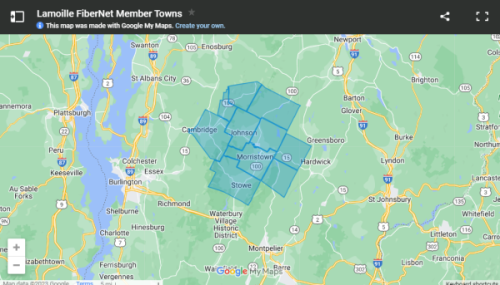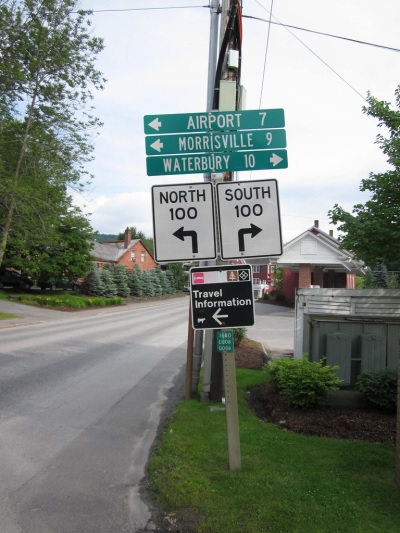
Fast, affordable Internet access for all.

Vermont’s nascent Communication Union Districts (CUD) are pioneering creative efforts to deploy affordable broadband to the rural parts of the Green Mountain State. That includes the Lamoille FiberNet CUD, which has greenlit a major new plan to expand affordable access to fiber in the most neglected parts of rural Vermont.
At an Aug. 14th meeting, the Vermont Community Broadband Board (VCBB) approved Lamoille FiberNet’s $1.3 million pre-construction grant, followed by a mid-September approval of the CUD’s $13.6 million construction grant.
“This grant means that, by the end of 2024, we can bring high-speed internet to almost all the homes and businesses in our CUD that are unserved or underserved,” Lamoille FiberNet Communications CUD Chair Jeff Tilton said in a statement.
With the Lamoille CUD covering 10 towns in the north central part of the state (Belvidere, Cambridge, Eden, Elmore, Hyde Park, Johnson, Morristown, Stowe, Waterville and Wolcott), Lamoille plans to have Fidium Fiber and Consolidated Communications deploy and manage 630 miles of new fiber connecting more than 4,800 unserved and underserved Lamoille County homes and businesses. The network will be deployed in two phases.

Phase 1 will cover the deployment of 550 miles of fiber, connecting 4,170 addresses by the end of 2024. Phase 2 will finish the job of reaching any remaining unserved customers, and should be completed in 2025. All told, Consolidated is expected to invest $10 million in the network, while the Lamoille FiberNet CUD will invest $14.9 million.
“We are grateful that the VCBB appreciated the merits of our plan, and we are very excited to start building,” Tilton said. “This plan came about after we explored several models, and we chose Fidium Fiber and Consolidated to build, operate and maintain the fiber network because it is the best option in terms of affordability and sustainability, and it also brings high-speed fiber internet to our communities significantly faster and with less costs than other models.”
Lamoille had previously been in talks with Google Fiber about a potential deployment partnership with another CUD, Northwest Fiberworx. The larger project would have featured Google Fiber as the network’s first anchor tenant, but fell apart last year after Google Fiber expressed skepticism about the viability of the project.

“Affordability is a key reason Fidium was chosen to serve Lamoille FiberNet CUD,” Lemoille FiberNet interim Executive Director Lisa Birmingham said of the pivot. “Their prices are significantly lower than most providers and they offer the Affordable Connectivity Program (ACP) for qualifying households “Fidium has also committed to using the same pricing and offering the same services to Lamoille FiberNet customers as it offers customers throughout Vermont and northern New England.”
Fidium currently offers residential customers symmetrical 50 Mbps (megabit per second) service for $35 a month ($55 after first year); symmetrical 250 Mbps service for $60 a month ($85 after the first year); symmetrical 1 Gbps (gigabit per second) service for $55 the first year, $65 the second year and $95 after that; and a symmetrical 2 Gbps tier for $75 a month the first year, $85 the second year, and $95 a month after that.
The company’s service tiers do not feature long-term contracts or usage caps.
While such public private partnerships often reduce the up front costs for municipalities, towns and cities may often find themselves with less overall control of the trajectory of the network–as well as the rates charged to local residents.
“Lamoille FiberNet will own certain fiber assets–in all ten towns–funded with grant dollars but not the entire network per se,” Birmingham told ILSR.
A Revolution in Community-Driven Collaboration

Vermont’s broadband policy leaders have embraced CUDs as the primary avenue to bridge the state’s long standing digital divide. That effort began in 2015, when the state passed a new law allowing two or more towns to form CUDs.
Under the law, CUDs can raise money for broadband deployments through grants, debt and donations–but not through taxes.
Such collaborations can help towns, cities, and counties share the cost and logistical burdens of broadband deployment. Establishing a CUD also puts rural underserved regions of Vermont in a position to borrow money on the municipal bond market, easing access to grants and loans to fund broadband projects often too costly and difficult for a town to manage alone.
A significant portion of the state’s $150 million 2021 broadband package is being funneled toward CUDs in a state where 85 percent of municipalities and 90 percent of underserved locations fall within a CUD.
CUDs are also poised to receive a notable chunk of the $229 million in BEAD (Broadband Equity And Deployment) funding made possible by the infrastructure bill.
State officials recently celebrated the “near completion” of a different collaboration between Southern Vermont Communications Union District and Consolidated. That $9 million project involved stringing 635 miles of new fiber optic cable across 14 towns in a bid to bring affordable broadband to 2,400 Vermont locations for the first time.
The Vermont CUDs’ heavy reliance on Consolidated hasn’t been without its critics. After the company lost $119 million in the second quarter and laid off five percent of its Vermont workforce, state regulators have begun taking a closer look at ways to ensure companies that receive grants to work with CUDs face meaningful accountability should they fail to deliver on project promises heavily subsidized with public funds.
The Vermont Department of Public Service states only 29 nine percent of state residents can obtain broadband at symmetrical speeds of 100 Mbps. Four percent of state residents have access to no broadband whatsoever, and 16 percent of state residents can only obtain speeds of 4 Megabits per second (Mbps) downstream, 1 Mbps upstream.
Despite The CUD Revolution And Federal Help, Cost Remains An Issue For Some
While CUDs are playing an essential role in bringing affordable broadband to locals long neglected by large regional broadband monopolies, the high cost of rural broadband deployment still often results in pricing that’s just out of reach for low-income families.
Data suggests that affordability remains the primary obstacle to U.S. broadband adoption, a problem markedly worse in minority or marginalized communities. Residents in Vermont’s Essex County, the poorest in the state, say that even with the arrival of CUDs, they’ve struggled to afford access.

Low-income residents in Vermont’s Northeast Kingdom tell indie news outlet Seven Days that they still struggle to afford $50 to $80 monthly cost of the cheapest service from their local CUD, NEK Broadband (see our story from June), noting that comparable service in other parts of the state costs between $25 and $35 per month.
The FCC’s Affordable Connectivity Program (ACP), which provides a $30 a month discount off of low-income broadband bills, has helped mitigate these costs for some, but the program is expected to run out of money next year, and renewal of the program is currently bogged down in government funding debates.
The Vermont Community Broadband Board recently released a Five Year Action Plan proposal on how to best spend the $229 million in BEAD funding the state will get thanks to the infrastructure law. With an eye on affordability, the plan notes that 50 percent of Vermont residents believe the cost of broadband is too high, and 28 percent of respondents without a home Internet connection cite high costs as a reason why.
“Vermont stakeholder organizations that work with low-income communities consistently raised the point that while the ACP is helpful, a $30 per month discount is not enough of a subsidy to make Internet affordable for many Vermont families, due to the high overall cost of service,” the VCBB said. “While maintaining funding for the ACP is crucial, these organizations believe that Vermont should consider a supplemental program to further subsidize the cost of service for families.”
Driving down consumer costs requires fighting monopoly power and boosting regional competition. The VCBB is quick to note that 52 percent of Vermonters live under a broadband monopoly, a problem decades in the making that–even with ample motivation, public support, and an historic round of public funding–simply won’t be fixed overnight.
Header image of Historic Grist Mill Covered Bridge in Lamoille County courtesy of Flickr user cmh2315fl, Attribution-NonCommercial 2.0 Generic
Inline map of Lamoille CUD service area courtesy of Lamoille CUD
Inline image of downtown Morrisville, VT courtesy of Wikimedia Commons, Attribution 3.0 Unported
Inline image of road signs courtesy of Flickr user Doug Kerr, Attribution-ShareAlike 2.0 Generic
